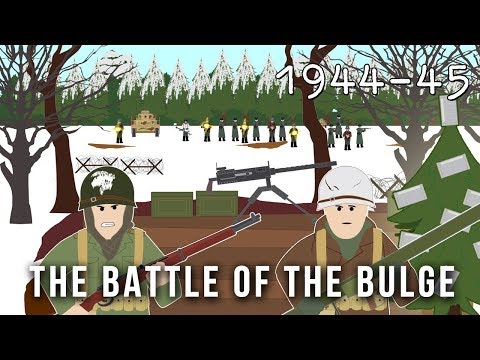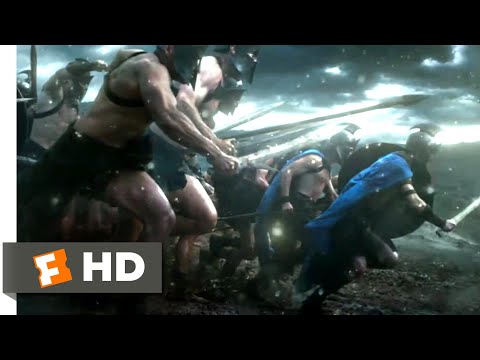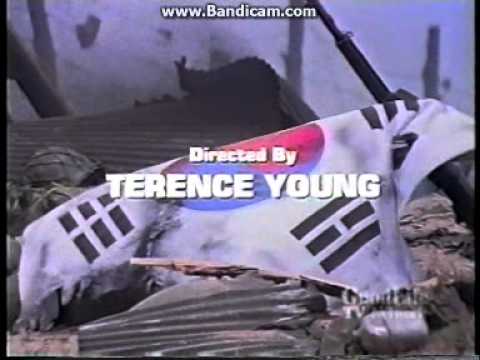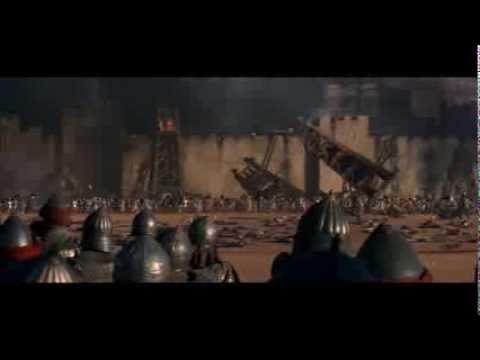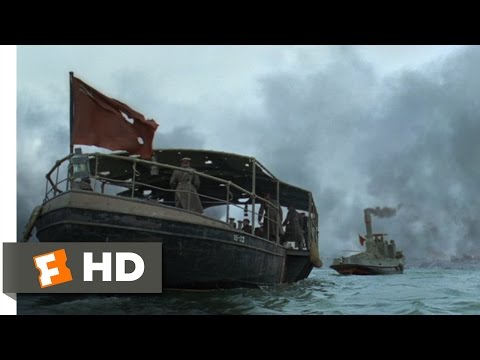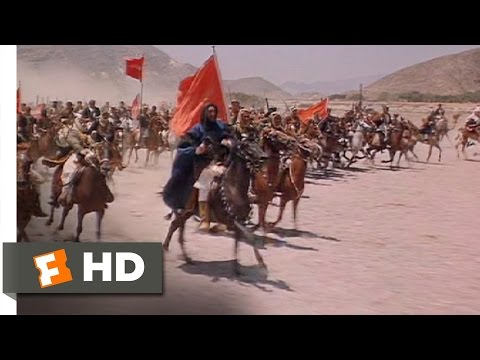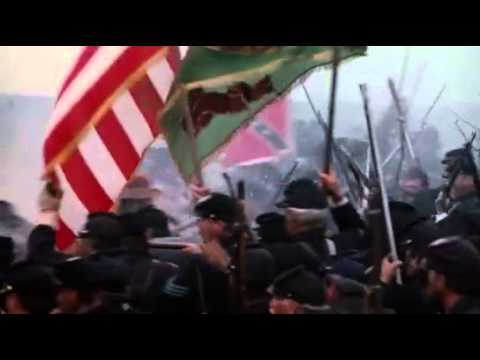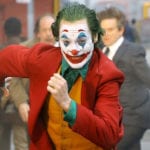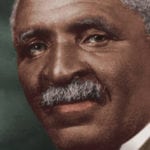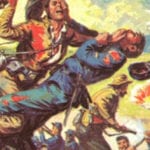10The Battle Of The BulgeBattle Of The Bulge (1965)
The Battle of the Bulge saw more American deaths than any other World War II engagement, so you’d expect MGM’s movie of the same name to strive for respectful accuracy. Unfortunately, the filmmakers apparently decided that the real thing wasn’t cinematic enough and just made up a different battle entirely. For starters, the filmmakers were determined to let audiences enjoy the picture in magnificent widescreen Cinerama. As a result, they ditched the rugged, claustrophobic forests of the Ardennes in favor of sweeping vista shots of flat, treeless plains. The result was more reminiscent of the popular cowboy movies of the time than the actual battle. MGM also decided to discard the thick fog that played such a pivotal role in the opening days of the battle. The resulting shots of German tanks thundering across the sunny plains are nice, but in reality such exposed tank formations would have been destroyed from the air almost immediately. Meanwhile, the screenplay itself was so inaccurate that former President Dwight Eisenhower, supreme commander of the Allied Forces at the time of the battle, felt the need to deliver a scathing critique. Right from the beginning, Eisenhower pointed out, the narrator got names and units wrong, including moving the entire British Eighth Army from Italy to the Ardennes. Eisenhower also pointed out that most of the plot lines were fictional, including a race for a fuel depot that never happened. And the movie wrongly depicted Nazi infiltrators as a real danger to the Allies, when in reality they were never anything more than an annoyance. Eisenhower also criticized the movie for using Korean War–era American tanks as German panzers. In fact, every tank, plane, and jeep used in the movie is a post-war model. In fairness, the difficulty of finding accurate military hardware would plague all movies prior to the age of CGI, although MGM could at least have painted over the Spanish Army camouflage on their jeeps.
9Marathon And Salamis300: Rise Of An Empire (2014)
In 2007, Warner Bros. had a huge hit with 300, a visually striking depiction of the Battle of Thermopylae. The movie was criticized for historical inaccuracy, including the decision to depict the horrendously oppressive Spartan slave-state as some sort of beacon of liberty. However, the story was entirely narrated by a Spartan soldier and the filmmakers insisted that any exaggerations were down to the character. But even that flimsy excuse can’t account for 300: Rise Of An Empire, in which no empires rise and the narration ends before the story does. The movie opens on the Battle of Marathon, fought between the Athenians and a Persian invasion force in 490 BC. The Athenian general Themistocles leads his men at a full sprint to surprise the Persians as they are debarking from their ships. In reality, the Greeks and Persians faced each other at Marathon for five days before they fought. It is true that the Greeks ran straight at the Persian army, but it was to reduce their advantage in archers rather than an attempt to surprise them. In the film, the battle culminates when Themistocles shoots an arrow which kills the Persian king Darius I as his son Xerxes watches. To be picky, a Greek hoplite like Themistocles wouldn’t have been proficient with a bow. To be less picky, Darius was nowhere near Marathon and died years later of old age. Enraged, movie Xerxes transforms himself into a glowing giant and prepares to invade Greece. To lead his fleet, he recruits Eva Green’s Artemisia. In reality, Artemisia was the widowed queen of Halicarnassus and provided a handful of ships to Xerxes’ 600-boat navy. She personally commanded her own ships and was respected by Xerxes, but she wasn’t in charge of the whole fleet. The climax of the movie is the naval Battle of Salamis, which historians agree did not involve giant metal ships or Persian suicide bombers, both of which show up in the movie. Luckily, the day is saved by the narrator, Queen Gorgo of Sparta, who arrives with a huge fleet to destroy the Persians. Of course, the historical Sparta added a mere 16 boats to Themistocles’ 400 ships and played no significant role in the victory. Gorgo certainly wasn’t there and the misogynistic Greeks would never have allowed a woman to lead them anyway.
8The Battle Of InchonInchon! (1981)
Inchon! is very probably the worst war movie ever made. Critics called it “stupefyingly incompetent” and “a turkey the size of Godzilla.” The fact that the movie was financed and produced by Reverend Sun Myung Moon and his controversial Unification Church didn’t help matters. But Moon did do his research, hiring tabloid psychic Jeane Dixon to contact the deceased General Douglas MacArthur via the astral plane. Luckily, the general’s ghost was happy to endorse the movie and personally picked the director. Moon even included a quote from the spirit in the movie’s press release: “I was very happy to see this picture made because it will express my heart during the Korean War. I will make more than 100 percent effort to support this movie.” With the spirit world on board, Moon plowed an incredible $46 million into the production. As a result, he felt entitled to insert a scene featuring his favorite ballet troupe and tried to get the director to include subliminal images of Jesus. He also spent $3 million reshooting a crowd scene because the original crowd was too small. Yet the completed film includes grainy stock footage and model fighter planes visibly held up by strings. It’s hard to be sure if most of the movie is inaccurate, because it’s impossible to tell what’s supposed to be happening. A large chunk is just context-free shots of North Korean soldiers machine-gunning civilians. The Battle of Inchon itself is only given 15 minutes, most of which is pure fiction. Despite the expense, the battle scenes look cheap, with extras throwing themselves to the floor before explosions actually happen. Inchon! only made $5 million at the box office and is considered one of the biggest flops in movie history.
7The Siege Of JerusalemKingdom Of Heaven (2005)
Very few historical events are as controversial as the crusades, so it was courageous of Ridley Scott to tackle the subject in the epic Kingdom Of Heaven. Scott decided to set the first half of the movie during a truce maintained by King Baldwin IV of Jerusalem and the famous Muslim ruler Saladin, referring to it as a time when “anyone could come and go as they pleased, and worship as they pleased.” Sadly, Baldwin (memorably played by Edward Norton in a silver mask) dies of leprosy and the peace is undermined by wicked Christian fundamentalists like Guy de Lusignan and the Knights Templar. The moral is obvious and delivered with all the subtlety of a trebuchet. But it’s not really historically accurate. For starters, Baldwin IV wasn’t exactly the moderate modern figure the movie tries to portray him as. Non-Christians were officially banned from Jerusalem during his reign and he once flew into a rage when supposed warmonger Guy de Lusignan failed to attack Saladin. The Muslim leader is himself portrayed as an entirely peaceful ruler forced into war against his will, but the real Saladin worked to capture Jerusalem throughout his reign. Baldwin and Saladin fought each other for years and their truce had more to do with general exhaustion and problems elsewhere than a genuine desire for lasting peace. But these are minor quibbles compared to the movie’s protagonist: Balian of Ibelin (Orlando Bloom). In pursuit of Scott’s message, Balian is portrayed as a French blacksmith who has a crisis of faith when his wife commits suicide and is denied burial on holy ground. To really hammer it home, the town priest has her corpse beheaded and steals from her grave. In reality, Balian was a nobleman from Palestine, was never a blacksmith, was never a religious moderate, and his wife never committed suicide. In the movie’s climax, Balian escapes the disastrous battle at the Horns of Hattin and leads the defense of Jerusalem against Saladin’s forces, despite being undermined by the cowardly Christian patriarch of Jerusalem. The real Balian led the defense of Jerusalem in cooperation with the patriarch, who certainly wasn’t his enemy, but the movie can’t risk portraying the clergy in even a mildly positive light. In a ridiculous scene, Balian negotiates safe passage for Jerusalem’s Christian inhabitants by threatening to destroy “your holy places and ours. Every last thing in Jerusalem that drives men mad.” In response, Saladin wonders “if it would not be better if you did,” which is so far removed from the pious historic Saladin that he might as well have been portrayed as a talking gerbil. In reality, Balian threatened to destroy specifically Muslim holy sites. He also threatened to murder around 500 Muslim slaves he was holding in the city. In the movie, Saladin nobly agrees to let the Christians leave peacefully. In history, the Christians had to ransom themselves and those who couldn’t pay were taken into slavery.
6Operation Red WingsLone Survivor (2014)
Lone Survivor tells the story of four members of SEAL Team 10 who were sent into the Afghan mountains to surveil a Taliban wannabe named Ahmad Shah. The team was accidentally discovered by three goatherds, who presumably informed the Taliban of their presence. Approximately 50 Taliban fighters attacked the team, prompting a three-hour running fight down a mountainside. Three members of the team were killed, while Marcus Luttrell alone survived. A further 16 American servicemen were killed when their helicopter was shot down while trying to reach the original group. Naturally, the filmmakers tried to take a respectful approach to the story. But that doesn’t mean elements of the movie weren’t fictionalized for entertainment value. For example, the opening scene shows Marcus Luttrell’s heart stopping just as he is rescued. The rest of the movie is a flashback from that moment. In reality, Luttrell’s heart did not stop and he wasn’t close to death when he was rescued. This fiction subverts one of the truly amazing things about Luttrell’s story: that he wasn’t near death. In an interview, Luttrell catalogued his injuries: “I had to have my hand reconstructed. My back’s been reconstructed. Multiple back surgeries. My knees are blown out, my pelvis is cracked, I had maxillofacial damage, I bit my tongue in half. I got shot-fragged by RPGs and grenades, eleven through-and-throughs in my quads and calves, shrapnel stickin’ out of my legs and everywhere. All the skin off my back and the back of my legs was gone.” In addition, he also suffered a broken nose, torn shoulder and a bacterial infection from the water he drank while on the run. At the end of the movie, the injured Luttrell is discovered and taken to a local Pashtun village where a man named Gulab cares for his wounds. Shah’s thugs track Luttrell to the village and one of them is about to behead the American when the villagers intervene. In response, Shah’s men attack the village. Gulab is shot and his hut is blown up. But American forces arrive just in time to blast the Taliban to smithereens and kill Shah. The climactic firefight is a typical Hollywood ending, which is a good sign that it didn’t actually happen. Luttrell was indeed taken to a Pashtun village and cared for by a man named Gulab. He was also discovered by the Taliban, who broke his hands, but did not try to behead him before the villagers drove them off. Shah’s men didn’t attack the village and Gulab wasn’t shot. Luttrell was simply picked up by US Rangers alerted by the locals—the rescue was so uneventful that the Rangers had tea with the villagers before taking Luttrell out by helicopter. And Shah? He didn’t die for another three years. Luttrell’s story is genuinely amazing, but apparently the ending wasn’t quite dramatic enough for Hollywood.
5StalingradEnemy At The Gates (2001)
Movies about the Eastern Front of World War II are fairly rare, so it’s unfortunate that the Stalingrad epic Enemy At The Gates makes little effort at historical accuracy. The movie can’t even get basic maps right, opening with an image depicting Switzerland and Turkey as German conquests. Meanwhile, the filmmakers seem to have been worried that recognizing the Soviet Union’s gigantic contribution to winning the war might also paint communism in a positive light. As a result, the movie portrays individual Soviets as heroes but misses no chance to make the Soviet war effort as a whole look cruel and incompetent, even when actual events don’t back that up. For example, the movie starts with Jude Law’s Vasily Zaytsev, based on the real sniper of that name, locked into a train with his fellow soldiers. Soviet military train doors were actually left unlocked so the soldiers could jump out and take cover in an air raid. When the train arrives at the depot, no officers or NCOs are present to organize the troops into platoons or companies. Instead, political commissars herd the men into boats to cross the Volga in broad daylight, allowing German planes to inflict huge casualties. In real life, Soviet units crossed the river under the cover of darkness. In Stalingrad, Zaytsev’s unit is ordered to charge the Germans en masse. Only half of them are given rifles, with the rest told to follow them and pick up the rifles of the dead. This is based on isolated incidents during the confusion of the surprise German invasion in 1941 and was certainly never a deliberate strategy. There is no evidence that Soviet soldiers were ever sent into Stalingrad without guns. They also didn’t stage mass frontal charges against machine guns, which would have been idiotic. But all of this is nitpicking, since the main plot of the film revolves around a duel between Zaytsev and a German sniper named Major Erwin Konig. No such German sniper has been found in the records and most historians believe that the Soviets simply made him up to increase Zaytsev’s propaganda value.
4The Taking Of AqabaLawrence Of Arabia (1962)
Lawrence Of Arabia is considered one of the greatest movies of all time, but that doesn’t mean it doesn’t take a few liberties with the truth. We’ve already mentioned how Auda abu Tayi was altered from a cultured, intelligent man to a greedy brute, while one of Lawrence’s siblings said that he “had a hard time recognizing my own brother.” Much of the film centers on a critical raid on the Red Sea port of Aqaba. The port was protected from attack along the coast, but Lawrence came up with a plan to take a small party through the Nefudh Desert, allowing them to attack Aqaba from inland. The movie gets that much right, but struggles with the remaining details. For starters, the movie depicts the Nefudh Desert as a magnificent sea of undulating golden sand dunes. In reality, most of the areas traversed by Lawrence were gravel plains. Along the way, Lawrence rescued an Arab who was left behind in the desert. In the movie, the Arabs celebrate him as a hero and give him a beautiful Bedouin robe, symbolically accepting him as one of their own. But by Lawrence’s own account, he had been wearing Bedouin garb for six months at that point. And the Arabs thought his dangerous rescue efforts were moronic and berated him for risking two lives instead of one. In one of the most film’s most famous scenes, Lawrence leads a mounted charge straight into the city. In reality, the pivotal cavalry charge happened 65 kilometers (40 mi) from Aqaba at a small outpost called Aba el Lissan. Lawrence’s force outnumbered the Ottomans in the outpost by nearly three to one but still couldn’t dislodge them. Lawrence eventually insulted the Arabs into attacking and they, not Lawrence, led the charge to take the outpost. He did try to participate in the charge, but he accidentally shot his own camel in the head and was thrown ingloriously to the ground. Aqaba was taken without incident the next day.
3The Battle Of GettysburgGettysburg (1993)
When New Line Cinema released the film adaption of Michael Shaara’s Pulitzer Prize–winning novel, they boasted that the movie was “rigorously authenticated down to the boots.” But that doesn’t mean there weren’t a few minor details for historians to pick at. For starters, the extras in the battle scenes were mostly hobbyist Civil War re-enactors, who provided their own uniforms. This was a significant saving for the filmmakers, but meant that the uniforms were too pristine to accurately represent the ragged forces at Gettysburg. Many re-enactors were perhaps too well-fed to portray Confederate soldiers who had just marched hundreds of miles. At one point, General Lee shakes hands with a soldier sporting a clear tan line from a wristwatch. For dramatic effect, the events of the battle were shifted in time. The movie opens with the scout Harrison reporting to Longstreet on the morning of June 30. The real Harrison had to have informed Longstreet of the Union’s movements no later than June 29. Lee’s angry confrontation with General Heth over his initial engagement happened late on July 1, not during the battle earlier that day. The famous scene where Father Corby delivers absolution to the Irish Brigade did not happen in the morning of July 2, but in the afternoon just before they went into battle. The tension of Pickett’s Charge is somewhat undercut if you notice the rubber bayonets wobbling around. Confederate cannon can be seen blowing up, but the Southerners actually didn’t lose a single cannon in the battle. General Kemper is depicted as dying from a mortal wound, 32 years before his actual death in 1895. But the most noticeable change is how bloodlessly the film depicts Pickett’s Charge. One eyewitness described the real charge as a “hurricane of violence in which human debris literally filled the air.” The filmmakers probably toned it down to keep their PG rating, but the result was a whitewashed scene that one critic described as a “remarkably non-violent, clean, and heroic little parade.”
2The Fall Of The AlamoThe Alamo (1961)
The makers of 1960’s The Alamo tried to sell the movie as a faithful depiction of the real battle. The director, producer, and star of the film—John Wayne—claimed that the sets were based on “original blueprints” of the Alamo. No such blueprints exist and the wildly inaccurate sets were mostly the product of art director Al Ybarra’s imagination. Wayne also claimed that the screenwriter, James Grant, had thoroughly researched the battle. If he did, he didn’t incorporate any of his research into the script. Grant’s screenplay was entirely fictional, to the point that two historians hired as consultants stormed off the set in a huff. Both historians later asked that their names be removed from the credits. It’s hard to even know where to start with the movie itself, which historians have described as containing “not a word, character, costume, or event that corresponds to historical reality in any way.” It can’t even get geography right, inexplicably claiming that the Alamo was located on the Rio Grande. The movie’s version of the battle focuses on a huge bombardment by Mexican cannons. Wayne’s Davy Crockett even leads a party to blow up the largest Mexican artillery piece. In real life, the Mexicans deployed only small field pieces at the battle. The adobe Alamo would have been completely leveled by heavy artillery. In the movie’s final battle scene, Crockett sacrifices himself to blow up the powder magazine. In reality, a defender named Robert Evans attempted to ignite the gunpowder with a torch but was shot before he entered the magazine. Crockett’s fictional sacrifice might have been more meaningful if the movie had ever mentioned why he went to the Alamo or what the men there were fighting for. But Wayne wanted the movie to be a Cold War metaphor, featuring patriotic Americans fighting an evil dictatorship, which worked better if the actual circumstances of the Texas Revolution were left obscure.
1Cowpens And Guilford CourthouseThe Patriot (2000)
The story of The Patriot illustrates how Hollywood struggles with the nuances of real history. Originally, The Patriot was supposed to be a biopic of Francis Marion, a guerrilla fighter in the South Carolina swamps during the Revolutionary War. Marion was a compelling figure whose ambush tactics would have provided an interesting contrast to George Washington’s stand-and-fire battles. But that movie never got made. Marion’s life simply didn’t fit easily into the standard Hollywood action-movie template. Among other things, he owned slaves and fought in a particularly brutal campaign against the Cherokee during the French and Indian War. He also didn’t have children, but the screenwriter wanted the movie to depict “the conflicting responsibilities of principle and parenthood.” So the character was renamed Benjamin Martin and made a composite of at least five historical figures. The fictional Benjamin Martin is clearly more palatable to modern movie audiences than Marion would have been. Unlike Marion, Martin frees all his slaves before the start of the movie. Luckily, they all inexplicably continue working on his estate anyway. It seems like it would have been easier to simply not depict Martin as owning a gigantic cotton plantation, but the scenery is admittedly beautiful. While Martin admits to carrying out a massacre during the French and Indian War, it involved killing enemy soldiers who had just slaughtered women and children. In reality, Marion didn’t carry out such a massacre, but he did help destroy buildings and food supplies in the hope that the Cherokee (including women and children) would starve to death during winter. This wasn’t his idea and he was actually horrified by it, but it’s still less easy to cheer for than Martin’s righteous retribution. But the filmmakers were evidently still worried that Martin might be too morally ambiguous. So they made his British enemies into monstrous villains who cheerfully committed war crimes whenever possible. In one scene, redcoats lock an entire town into a church and burn it down. That didn’t happen during the Revolutionary War, but the scene resembles a famous World War II German atrocity. Naturally, the British were unhappy with their ancestors being depicted as Nazis. Unfortunately, they overcorrected, and many British newspapers published articles claiming that Marion was a rapist who “hunted Indians for fun.” Ironically, the real Francis Marion doesn’t seem to have held much ill will toward the British, since he later campaigned against punishing Americans who had fought for them. The movie’s final battle is unnamed and mostly fiction, although it uses elements of the battles of Cowpens and Guilford Courthouse. At Cowpens, militia leader Daniel Morgan ordered his men to fire two shots before retreating, pulling the redcoats into a trap. In the movie, both General Nathaniel Greene and his British counterpart, General Charles Cornwallis, were at the unnamed battle. Neither were at Cowpens, but both were at Guilford Courthouse. The battlefield in the film also looked strikingly like that of Guilford Courthouse. Steve is the author of 366 Days In Abraham Lincoln’s Presidency: The Private, Political, And Military Decisions Of America’s Greatest President. His work has appeared in KnowledgeNuts and Gizmodo.
